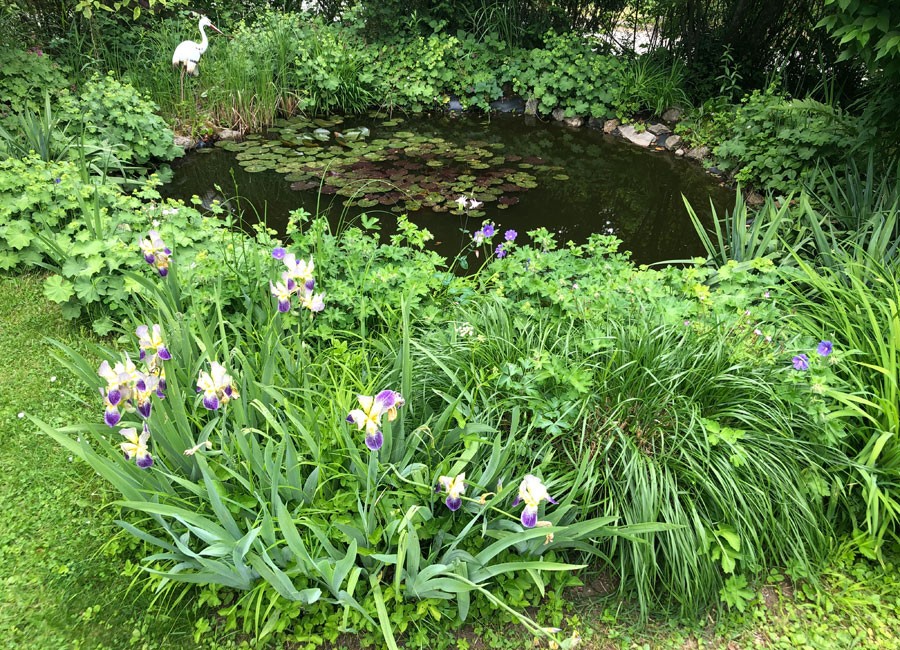As soon as the gardening season really gets going in spring with mild temperatures, the garden pond is naturally an issue. After the winter, the pond is not only generally spruced up, but above all can be replanted. Here are personal favorites among the pond plants:
- The water lily: they come in all sizes and colors and can be purchased at any retailer. The Nymphaea is the queen among the pond plants, in total there are about 50 subgenera, so you are really spoiled for choice.
- Water buttercup: The common water buttercup is a floating plant that blooms white – from April to September! So you can enjoy it extensively.
- Marsh iris: a beautiful plant for the edge of the pond. The marsh iris can grow up to 2 meters high and blooms in fresh yellow, unfortunately only for about 2 months.
- Frogweed: The frogweed is visually a good alternative to the water crowfoot. It also blooms white and is somewhat reminiscent of small water lilies.
Another tip from the experience of recent years: reed and cane plants are also very suitable for a garden pond. However, consider to what extent and in what place you plant them. Reed plants spread quickly and then also take up larger areas at the pond. Without regular thinning, shallow areas of the pond risk silting up. In addition, some reed species grow very tall – possibly obscuring the view of your water body and its flowering pond plants. In general, regular pruning of plants around the pond is recommended to preserve the water surface and keep it from shrinking.
Choosing the right pond plants for your garden pond is essential for creating a healthy, balanced, and aesthetically pleasing aquatic ecosystem. Different types of pond plants serve various functions, from adding beauty and shade to water purification and providing habitat for aquatic life.
Here’s a guide to help you select the right pond plants for your garden pond:
1. Aquatic Plants:
- Water Lilies (Nymphaea spp.): Water lilies are prized for their exquisite flowers, which float on the water’s surface. They provide shade, which helps reduce algae growth and benefit fish by offering hiding spots.
- Lotus (Nelumbo spp.): Lotus plants are known for their stunning, large blooms. They thrive in deep ponds and are often planted in pots below the water’s surface.
2. Marginal Plants:
- Cattails (Typha spp.): Cattails are well-suited for the shallow edges of your pond. They provide vertical interest, habitat for wildlife, and improve water quality.
- Pickerel Weed (Pontederia cordata): These tall, spike-like plants with blue or violet flowers are excellent for attracting pollinators. They grow along the water’s edge.
3. Floating Plants:
- Water Hyacinth (Eichhornia crassipes): These floating plants have striking lavender flowers and help control excess nutrients in the water. They float on the surface.
- Water Lettuce (Pistia stratiotes): Water lettuce forms rosettes of velvety, light green leaves that float on the water. They help provide shade and remove excess nutrients.
4. Oxygenating Plants:
- Hornwort (Ceratophyllum demersum): Hornwort is a submerged plant that provides oxygen and absorbs excess nutrients. It’s excellent for maintaining water clarity.
- Anacharis (Egeria densa): Anacharis is another submersed plant that oxygenates the water and serves as a nutrient buffer.
5. Submerged Plants:
- Vallisneria (Vallisneria spp.): Vallisneria, or eelgrass, is a rooted submerged plant that offers shelter for aquatic creatures and helps reduce algae by consuming excess nutrients.
- Fanwort (Cabomba caroliniana): This submerged plant has delicate, feathery leaves that oxygenate the water and provide habitat for small fish and invertebrates.
6. Bog Plants:
- Iris (Iris spp.): Iris plants are perfect for the moist, boggy areas around your pond. They offer colorful flowers and add vertical interest.
- Bog Lily (Saururus cernuus): Bog lilies thrive in shallow water or wet soils near the pond’s edge and produce fragrant white flowers.
7. Floating Islands (BioHaven):
- Floating islands are man-made structures that provide additional habitat for wildlife and help filter water. They are planted with a variety of wetland plants and can be an ecological enhancement to your pond.
When choosing pond plants, consider factors such as the size of your pond, water depth, climate, and the specific needs of the plants. Ensure that you plant them in appropriate containers or planting pockets designed for aquatic plants to prevent them from spreading too aggressively. Additionally, monitor and maintain your pond regularly to ensure the plants remain healthy and the ecosystem is in balance. The right combination of pond plants can enhance the beauty and functionality of your garden pond while supporting aquatic life.


